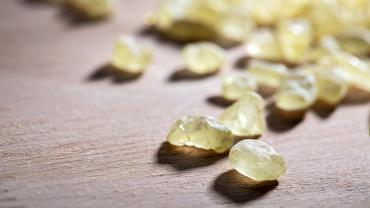
Mastic gum is an herbal remedy with historical significance. Hailing from the island of Chios in the Aegean sea and other dry, rocky areas in the Mediterranean, the resin of the mastic shrub (Pistacia lentiscus) has been used medicinally for centuries. In the first century, the Greek physician and philosopher Dioscorides described the use of mastic gum for mild gastrointestinal disorders in “De Materia Medica.” Mastic gum was also historically used as a spice, a wine flavoring agent, and for embalming Egyptian mummies in the 7th century BCE.
Mastic gum contains more than 120 chemical compounds, including triterpenes, sesquiterpenes, and oleanonic and oleanolic acids. Oleanonic and oleanolic acids act as peroxisome proliferator-activated receptor (PPAR) modulators, which are important in fatty acid metabolism and are believed to be a contributor to the antioxidant and anti-inflammatory properties of mastic gum. An animal study showed that extracts from mastic gum reduced the expression of tumor necrosis factor-α and participated in the inhibition of protein kinase C, both of which are involved in oxidative process activation. A laboratory study using an extract of mastic gum restored glutathione levels and showed inhibition of cellular apoptosis in a cell culture of peripheral blood mononuclear cells.
Helicobacter pylori (H. pylori) is a bacterium that infects almost half the global population, and it promotes a gastric inflammatory response and contributes to the development of certain gastric pathological conditions, including peptic ulcers and gastric cancer. H. pylori infection has also been linked to diseases outside the digestive system, including nonalcoholic fatty liver disease, diabetes mellitus, iron deficiency anemia, and some cardiovascular disorders. Mastic gum has been shown in laboratory studies to cause morphological abnormalities in H. pylori cells, and it has killed 90% of H. pylori strains at a concentration of 500 micrograms/mL. Arabinogalactans, constituents of mastic gum, may be a contributor to the anti-H. pylori activity of mastic gum, and a laboratory study containing arabinogalactans showed an effect on the viability of H. pylori.
Human studies also show that mastic gum may support gastrointestinal health. One study showed that daily administration of mastic gum for 2 weeks to individuals with a duodenal ulcer provided symptomatic relief. Another study showed that daily supplementation for 2 months inhibited H. pylori neutrophil-activating protein (HP-NAP), which is believed to contribute to the pathogenesis of H. pylori-related gastric diseases, such as peptic ulcer disease. While the resin from the mastic shrub (Pistacia lentiscus) is most commonly used medicinally, the essential oil from P. lentiscus leaves was shown to affect H. pylori strains, including those which were drug resistant.
The resin and other parts of the P. lentiscus plant have been used medicinally for centuries. Recent studies show that supplementation with mastic gum may support gastrointestinal health through its antioxidant and anti-inflammatory properties, and as its effect on H. pylori infection.
By Colleen Ambrose, ND, MAT